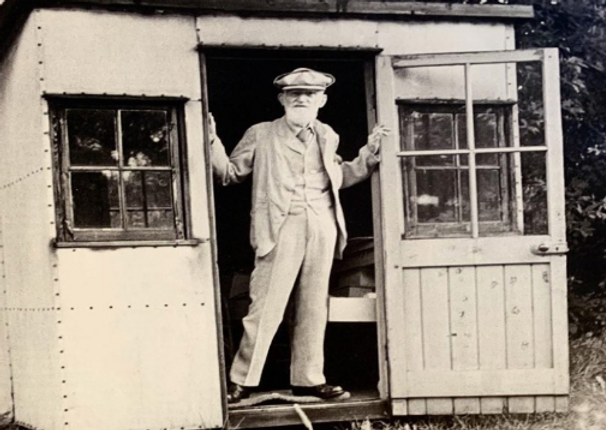Seven decades after his death, George Bernard Shaw is remembered for his prodigious body of work as a playwright, but also — and at least as much — for his personal eccentricities: the then-unfashionable teetotaling vegetarianism, the rejection of vaccines and even the germ theory of disease, the all-wool wardrobe. Thus, even those casually familiar with Shaw’s life and work may not be terribly surprised to learn that he not only had an outbuilding in which to do his work, but an outbuilding that could be rotated 360 degrees. “Shaw’s writing refuge was a six-square-meter wooden summerhouse, originally intended for his wife Charlotte,” writes Idler’s Alex Johnson. “Built on a revolving base that used castors on a circular track,” it was “essentially a shed on a lazy Susan.”
The hut became a part of Shaw’s formidable public image in a period of the early twentieth century “when there was a growing appreciation of idyllic rural settings — a knock-on effect of which was that people had garden buildings installed. Shaw made the most of this movement, promoting himself as a reclusive thinker toiling in his rustic shelter, away from the intrusions of press and people alike, while at the same time inviting in newspapers and magazines and posing for photos.”
In 1929, “Shaw stood in front of his hut for a photo for Modern Mechanics & Inventions magazine to promote the idea of sunlight as a healing agent.” Hence the importance of rotating to catch its rays all day long through windows made of Vitaglass, “a recent invention that allowed UV rays to come through, letting, the makers said, ‘health into the building.’”
However odd some of Shaw’s views and practices, one can’t help but imagine that at least some of them contributed to his longevity. The 1946 British Pathé newsreel above pays him a visit just a few years before his death at the age of 94, finding him still writing (he still had the play Buoyant Billions ahead of him, as well as several other miscellaneous works), and what’s more, doing so in his hut: “Like G. B. S. himself,” says the narrator, “it pretends to be strictly practical, with no nonsense about it.” Yet Shaw seems to have had a sense of humor about his theoretically humble workspace, naming it after the English capital so that unwanted visitors to his home in the village of Ayot St Lawrence could be told, not untruthfully, that he was in London. But one naturally wonders: when he rang up the main house with his in-hut telephone (another of its highly advanced features), did his housekeeper say it was London calling?
Related content:
Roald Dahl Gives a Tour of the Small Backyard Hut Where He Wrote All of His Beloved Children’s Books
The Cork-Lined Bedroom & Writing Room of Marcel Proust, the Original Master of Social Distancing
Classic Monty Python: Oscar Wilde and George Bernard Shaw Engage in a Hilarious Battle of Wits
Who Wrote at Standing Desks? Kierkegaard, Dickens and Ernest Hemingway Too
The Daily Habits of Famous Writers: Franz Kafka, Haruki Murakami, Stephen King & More
Based in Seoul, Colin Marshall writes and broadcasts on cities, language, and culture. His projects include the Substack newsletter Books on Cities, the book The Stateless City: a Walk through 21st-Century Los Angeles and the video series The City in Cinema. Follow him on Twitter at @colinmarshall or on Facebook.
